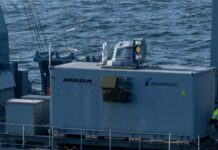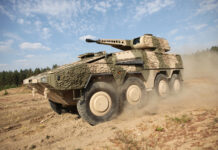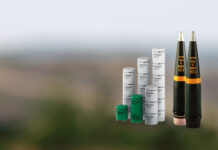Directed energy weapons (DEWs) are weapons that use highly focussed energy to damage or destroy their target. They can be used against personnel, missiles, all sorts of vehicles, and optical devices.
Three main types of highly focussed energy have been identified for their practical use in warfare: laser (emitting Light through a process of optical Amplification based on the Stimulated Emission of electromagnetic Radiation), microwaves (a form of electromagnetic radiation with specific wavelengths and frequencies), and particle beams (a stream of charged or neutral particles, moving at near the speed of light). Sound (a mechanical type of energy that causes waves of pressure due to vibration) is a fourth type of DEW, but the possibilities for military application seem rather limited.
Historical Developments
The first DEW usage is attributed to the third century BC famous Greek mathematician, physicist, engineer, inventor, and astronomer Archimedes. According to legend, he set the fleet of the Romans on fire as they invaded his Sicilian hometown of Syracuse by focusing the sunlight on a single point on their ships with the help of a mirror (or a series of mirrors) with an adjustable focal length. It is debatable whether this event really took place, but modern scientists have proven that, at least in theory, Archimedes’ DEW could have worked.

The search for DEW really took off in the 1930s as the world was preparing for a second world war. In the process of exploring the feasibility of a ‘death ray’, the British Air Ministry discovered that radio waves could be used for the detection of aircraft, thus giving the starting signal for the development of radar in Britain. The Germans conducted experiments with a ‘sonic cannon’ that caused vertigo and nausea (and potential lethal vibrations) in the target body by concentrating and amplifying sound. However, the weapon was deemed vulnerable and unpractical, and the research was soon abandoned. Another Wunderwaffe under construction was the ‘Rheotron’, an X-ray beam weapon designed to bring down aircraft. In 1945, it was captured by the Americans and further developed.
Effects
The deployment of DEW enables a wide range of high-level defensive and offensive non-kinetic options. In conjunction with kinetic energy systems, the DEWs can serve as a force multiplier.
When used against personnel, DEWs cause a variety of bio-effects. The use of microwaves can cause breathing difficulties, nausea, pain, vertigo, and general systemic discomfort. Interference with the breathing system of the target, gives the highest chance of a lethal outcome. The use of light and repetitive visual signals can induce epileptic seizures and provoke the occurrence of vection (illusions of self-motion) and motion sickness. DEWs also can be integrated in Active Denial Systems (ADS) designed for area denial, perimeter security, and crowd control.
When used against weapon systems, facilities, ships, vehicles, and equipment, the possibilities of DEWs seem endless: laser can be used in anti-missile defence, or to blind satellite sensors, destroy ammunition depots, or neutralise Unmanned Arial Vehicles (UAV’s). DEWs can cause permanent physical damage or temporary system disruptions and can result in fires or electric shocks to critical services. Electronic components, systems, and networks, from a high-tech plane or missile to the radio of a common soldier, can be destroyed or disrupted.
Advantages
The last decades have seen an exponential growth in investments, research, discoveries, and applications in the field of DEW. DEWs have certain advantages over conventional weaponry: first of all, the use of DEWs may be cheaper than their conventional counterparts; the effects of the deployment of DEWs, although potentially lethal and destructive, can also be mitigated, and therefore, the outcome of a conflict can be less expensive. Besides an economic reason, the logistical and operational advantages are manifold: logistical problems, in terms of ammunition supply, are significantly reduced. As long as there is enough energy to power the DEW, its functioning is assured (a so-called ‘deep magazine’). Also, the use of DEW is, in certain operational contexts, discreet: radiation above and below the visible spectrum is invisible and does not generate sound. This makes DEWs also very suitable for purposes of crowd control. DEWs travel nearly at the speed of light and have near infinite range, making them hard to discover or to counter. This characteristic also makes them very suitable for space warfare. Another advantage is that DEWs are essentially unaffected by gravity, day or night conditions, and the Coriolis effect (an effect whereby a mass moving in a rotating system, such as the earth, experiences a force that tends to deflect moving objects to the right in the northern hemisphere and to the left in the southern). The almost perfectly flat trajectory makes the aim more precise and considerably extends the line-of-sight range.
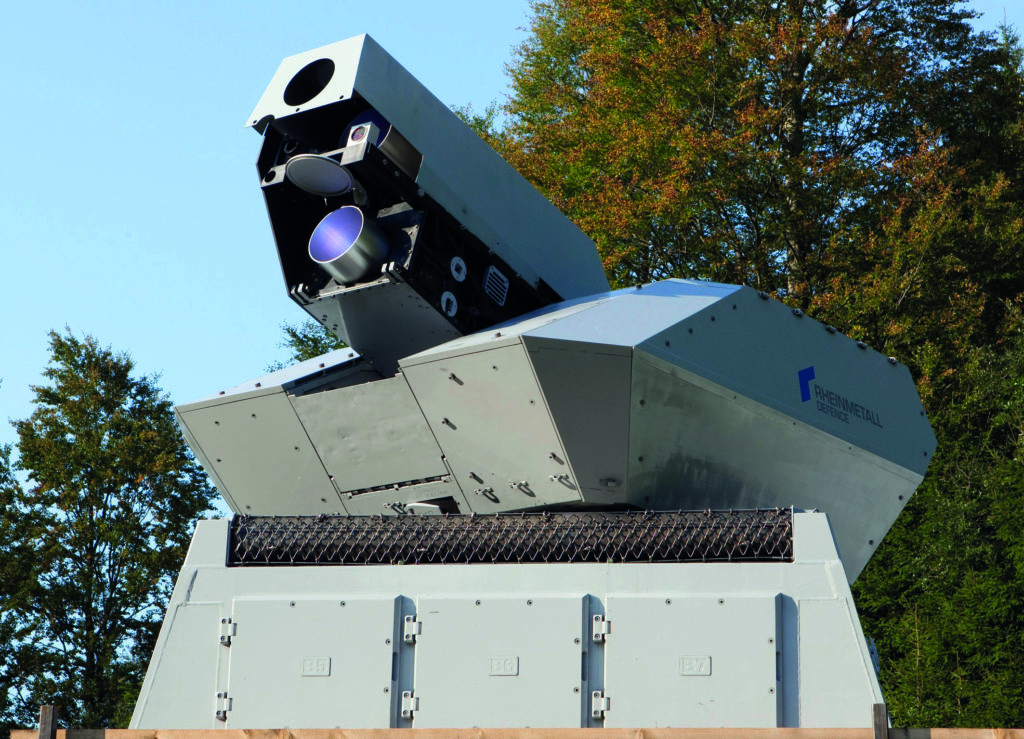
Disadavantages
After decades of research and development, directed-energy weapons are leaving the experimental stage, and it is likely that they will be deployed as practical, high-performance military weapons in the near future. However, two main disadvantages slow down the deployment on the battlefield.
First, the lack of experience with this kind of weapons makes it very difficult to predict their impact on the battlefield and on modern warfare in general. There is a consensus that the large-scale deployment of DEWs will revolutionise modern warfare, but how their integration in the existing weapons systems and operational planning processes can be achieved, is still a matter of debate. There are no ‘best practices’ and a lot of the thinking with regard to the political, strategical, operational and tactical consequences still needs to be done. Consequently, the development of doctrine and the writing, testing, and evaluation of the operational and tactical manuals is also still in an early phase. Training on the level of the individual soldier or the unit is possible, but large-scale joint exercises involving numerous conventional weapons systems, is yet a fiction.
Second, there are the legal constraints: little is known about the potential damage these weapons can inflict on human physical and psychological welfare, as well as against the civilian infrastructure. Some DEWs can cause the same effects as chemical weapons and radiation levels, energetic outbursts and temperatures can potentially reach levels comparable to those of nuclear weapons. Therefore, the large-scale deployment of DEWs in real conflicts will necessitate revisions or extensions of the existing law of armed conflict, humanitarian law, rules of engagement and international treaties. The fact that DEWs are particularly useful for spatial warfare, which itself is a legal minefield, further complicates legal matters.
Recent Developments
DEWs have been in the Research and Development phase for the past several decades. In recent years, R&D was speeded up and DEWs are gradually making their way from the drawing table and prototypes to military testing programmes. When the legal, tactical, and operational difficulties are overcome, the next steps will be acquisition, force integration, and finally, deployment on the battlefield. So far, Turkey is the only country that has DEWs in active service and it is reported to have shot down a Chinese-made drone in Libya with a laser weapon mounted on the back of an armoured car in August 2019. However, this does not imply that Turkey is ahead of all other nations in the development and deployment of DEWs: Ankara is just prepared to take more risks with weaponry that is not yet fully tested or hundred percent operational. Countries that invest heavily in the development of DEWs are the US, Israel, Russia, China, India, and the UK.
USA
It is no surprise that the US leads the race for operational DEWs. Between 2017 and 2019, the Defense Department doubled the annual budget for DEWs to US$1.1Bn. The Pentagon, the DARPA, the Air Force Research Laboratory, the US Army Armament Research Development and Engineering Center, and the Naval Research Laboratory are all researching DEWs to counter ballistic missiles, to develop hypersonic cruise missiles and hypersonic glide vehicles. The systems of missile defence are expected to become an operational reality in the course of 2020.
The US Air Force procured laser weapons to knock down drones from the sky. They work by heating an object until it catches fire, melts, or explodes. To defend against large swarms of drones, the USAF also bought a microwave weapon from the same provider Raytheon. Unlike a laser’s tight beam, the microwaves propagate in a cone shape, meaning they can engage many targets at once. The weapons come in a container-sized box, are C-130 transportable, and can easily be mounted on a small All-Terrain Vehicle (ATV). Deployment can take place within a couple of hours.
Lockheed Martin is working hard to provide capable DEW’s for use on the battlefield. Innovative fibre lasers, sophisticated beam control, and auxiliary technologies are combined with platform integration to enable offensive and defensive capabilities against a growing range of threats to military forces and infrastructure. Today, Lockheed Martin’s technology can defend against small rockets, artillery shells and mortars, small UAVs, small attack boats, and lightweight ground vehicles that are approximately a mile way. As fibre laser power levels increase, Lockheed Martin is convinced that the systems will be able to disable larger threats across greater distances.
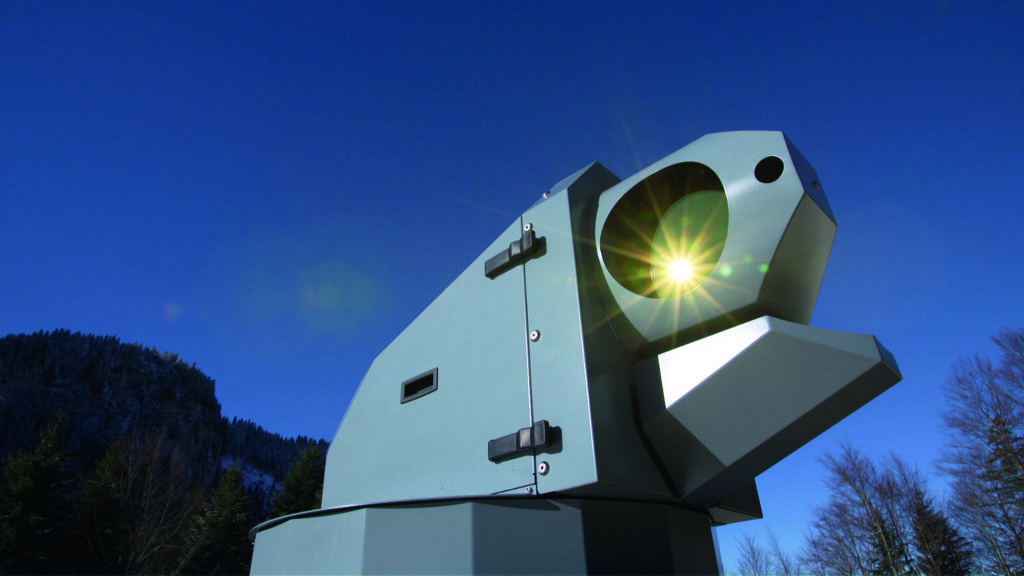
Israel
Israel is already familiar with DEWs, as it has numerous operational laser-based countermeasures against infra-red missiles, the so-called Directed Infra-Red Counter Measures (DIRCM). In January 2020, Israel announced a breakthrough of a laser-based missile interception system, complimentary to the IRON DOME system. The system is still under development, but the breakthrough regards the power of the laser beam on the one hand and its accuracy on the other hand. The Israeli laser should also be able to overcome atmospheric disturbances. Israel has invested heavily in R&D and can count itself among the leading countries in the field of high-energy laser systems. Demonstrations of Israel’s capabilities are scheduled throughout 2020. The Israeli system, most likely developed with the help of the US, would not only be effective against missiles and projectiles, but also against aircraft and drones. The new system offers three main advantages to Israel: it would lead to a drastic reduction in the cost of interception; it would overcome the limitation imposed by the numbers of intercepting missiles since directed energy requires no physical interceptors, and the scalable power makes it useful against a variety of human and non-human targets.
Russia
Russia has an operational laser weapon to perform the tasks of Air and Missile Defence. In 2017, Russia already started equipping its armed forces with the PERESVET, as the laser is called, and early 2018, it came on experimental combat duty. It is believed that since December 2019, five rocket divisions of the RVSN (Strategic Missile or Rocket Forces) have PERESVET on operational combat duty, in combination with the road-mobile Intercontinental Ballistic Missile (ICBM) launchers. However, the main function of PERESVET is to protect military bases and other locations from penetrations of UAV’s into their territory. Disadvantages of PERESVET are the enormous consumption of electricity and the difficulty to provide it, and the fact that it doesn’t perform effectively in bad weather conditions. But none the less, Russia is keeping up with other powers in the development and deployment of DEWs.
China
China recently disclosed the development of a new DEW, known as the ‘Chinese Laser Gun’. Although little detail was disclosed on the new weapon, the system is said to be designed for instantly obliterating targets near a coastal line, including small boats and UAVs. The weapon will first be used by the Navy of the People’s Liberation Army against low-end asymmetric threats. The scalable power levels of the system allow firing a non-lethal beam to dazzle a suspect vessel, and fire stronger beams to physically destroy a target. In addition, the Chinese Navy has begun trials at rough sea of the HAIYANGSHAN, its warship-mounted electromagnetic railgun installed on a tank-landing ship. The electromagnetic railgun is expected to be operational by 2025.
India
India has the vision for laser weapons as well as the scientific talent to absorb and build on the technology. Two laboratories of the Defence Research and Development Organisation (DRDO), the Centre for High Energy Systems and Sciences (CHESS), and the Laser Science & Technology Centre (LASTEC), have been working on developing laser weapons technology for the last few years. In July 2018, they achieved a first success with a vehicle-mounted 1-kilowatt laser weapon system. Since that initial test, India is progressively building more powerful laser weapons. It also seeks to establish partnerships with Israel and the US to profit from their know-how on the development of DEWs. India has long borders, a huge airspace, and with Pakistan as an enemy, and China as a regional competitor, India needs to contain the escalating costs of air defence. Laser-based weapon systems could provide an affordable solution. They can not only target drones, but also handle the increasing non-traditional threats that India is confronted with. Even more, laser weapons could turn out to be cheap anti-satellite weapons for a country that is determined to play a major role in the space race.
United Kingdom
The UK was among the first countries in the word to start experimenting with DEWs. It also developed one of the first operational laser weapons in the world, DRAGONFIRE. In 2017, a consortium of high-tech companies was assigned US$37M to develop a prototype of a laser gun under the lead of the Defence Science and Technology Laboratory. The system combines multiple laser beams to create one of the most powerful laser weapons systems yet developed. In its effort to prepare the armed forces for the battlefield of the 21st century, the UK MoD decided in July 2019 to drastically increase the R&D budget for DEWs. Starting in 2023, a number of tests will be conducted involving the Royal Navy and the Army, with a budget of US$162M. Within a decade, this Novel Weapons Programme should generate an output which is ready for use in combat. The new programme includes two high-energy laser demonstrators – one on-board a ship for air and surface defence applications, and a similar laser mounted on a land vehicle for short-range air defence and counter-surveillance applications. The third programme is aimed at demonstrating a high-power radio frequency weapon mounted on a land vehicle against aerial drones and to counter enemy movements. The weapon is designed to disrupt and disable an adversary’s computers and electronics.
Conclusion
This short overview of what is currently going on in the world of DEWs clearly demonstrates that the question is no longer if DEWs will play a major role on future battlefields, but when. Until recently, the destructive use of laser, particle beams or microwaves was reserved for science fiction movies like Star Wars, but it is becoming reality as we speak. The coming decade might witness a revolution in warfare comparable to the invention of gunpowder or the introduction of aircraft on the battlefield. For now, laser is the most popular type of highly focused energy for military applications. Laser has been used by the military for quite some time (to guide missiles to their target, for example), but much of the research now is focused on deploying laser as a weapon to disrupt or destroy UAV or smaller vehicles. It is only a matter of time before laser will be able to destroy larger targets. Microwaves and particle beams seem less popular at this time, but we have to take into account that the research and experiments are surrounded by the greatest secrecy. In order to evolve more, a solution has to be found for the high need of electric power that the implementation of these high-voltage weapons require. In the near future, we will see DEWs make their appearance on the battlefield. Much has to be learned yet with regard to the science behind directed energy and their applications in a military context, but the results so far are very promising. Especially in space, which is becoming more and more militarised, DEWs will be key for any power who desires to play a role there.
Joris Verbeurgt





